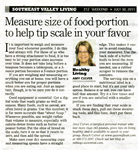 Measure size of food portion to help tip scale Measure size of food portion to help tip scale
in your favor
It is important to weigh and measure your food whenever possible. I still do this and always will. For those of us who have a strong attachment to food, it is too easy to let your portion sizes increase over time. It does not take long before a teaspoon becomes a tablespoon, or a 3-ounce portion becomes a 5-ounce portion.
If you are weighing and measuring everything you eat at home, you will have a much better eye for proper portions when you are eating out. Just as important, though, is to be sure you do it correctly.
Good equipment is essential. Get a digital scale that reads grams as well as ounces. Many foods, such as cereal, are often listed in grams. Use this number; it is far more accurate than "about ¾ cup." Whenever possible, use weight rather than volume to measure, especially with calorie-dense items such as butter or peanut butter. Put the slice of bread on the scale, turn it on so that it resets to zero, and then add the spread.
Make sure your dry measuring cups and measuring spoons have a straight edge. This makes it easier to avoid rounding your measures. Use the back side of a butter knife to level the item you are measuring. If needed, use a rubber scraper to remove the contents.
The serving size on a nutritional label is a good place to start, but it's not your only option. Believe it or not, you can have half that amount. Try it a few times and see if you are satisfied with a smaller portion.
If you are finding that your scale is stuck these days, pull out those measuring tools, and this time, don't put them back.
|

